Multivariate Statistics: Analysis of Outdoor Sporting Goods Data
VerifiedAdded on 2023/05/28
|10
|2574
|294
Report
AI Summary
This report details the utilization of multivariate statistics within the outdoor sporting goods industry, emphasizing techniques such as multiple regression analysis, logistic regression, discriminant analysis, MANOVA, factor analysis, cluster analysis, multidimensional scaling, conjoint analysis, canonical correlation analysis, and structural equation modeling. It identifies multiple regression analysis, multivariate analysis of variance, and conjoint analysis as particularly suitable for data mining in this context. The report provides examples of companies using these techniques, such as S&P's use of conjoint analysis for ranking and banks using multiple regression for cash flow prediction. It explains how upper management can leverage these methods for predicting sales, understanding customer preferences, and classifying risks. The preferred technique is multiple regression analysis due to its predictive capabilities, enabling data-driven decision-making and comparative analysis. Desklib provides this student-contributed solution and many more resources to aid students in their studies.
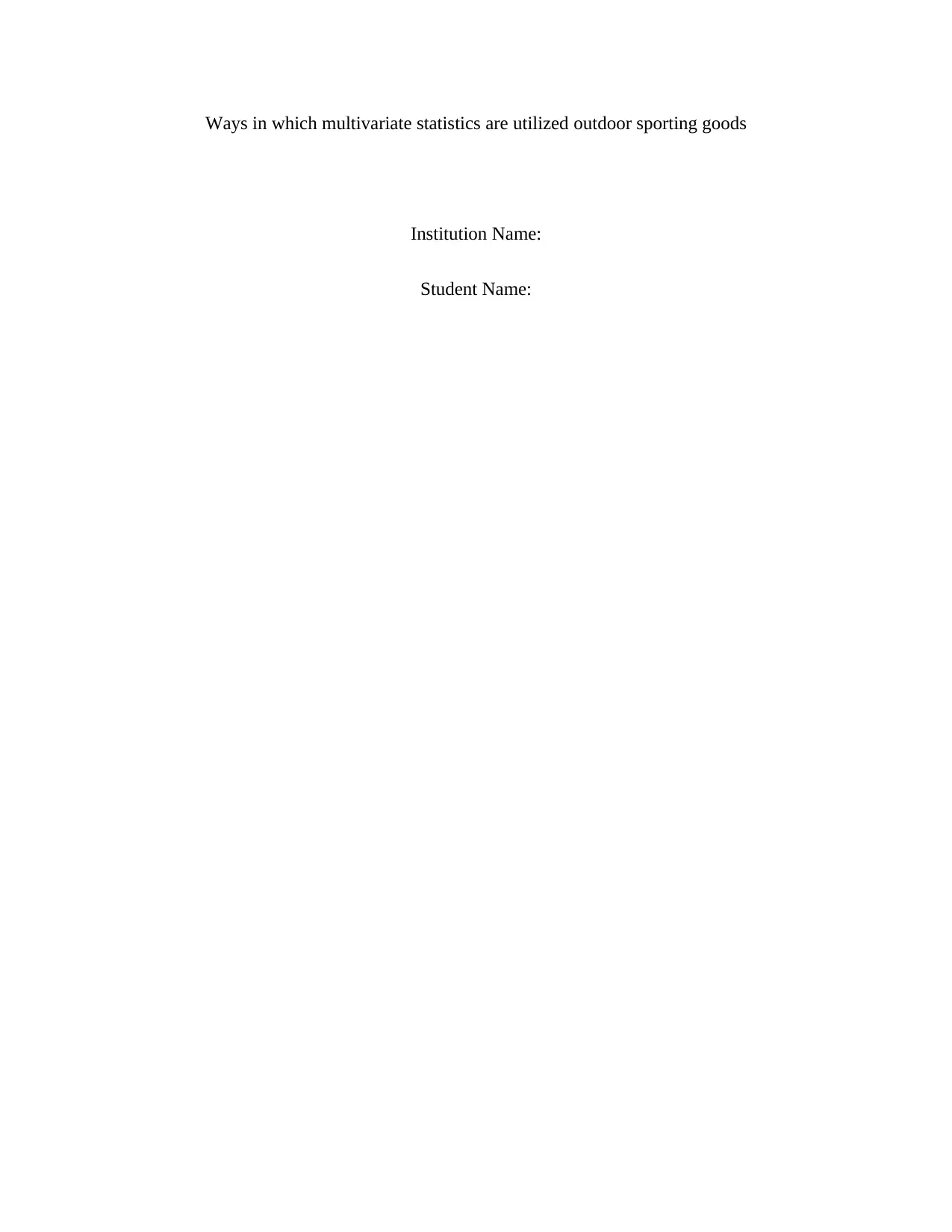
Ways in which multivariate statistics are utilized outdoor sporting goods
Institution Name:
Student Name:
Institution Name:
Student Name:
Paraphrase This Document
Need a fresh take? Get an instant paraphrase of this document with our AI Paraphraser

Contents
Major ways in which multivariate statistics are utilized in this scenario.....................................................2
Examples of a real company has used the techniques..................................................................................6
A summary to upper management...............................................................................................................7
Preferred Technique....................................................................................................................................8
What the manage management will learn from my selection......................................................................8
References...................................................................................................................................................8
Major ways in which multivariate statistics are utilized in this scenario.....................................................2
Examples of a real company has used the techniques..................................................................................6
A summary to upper management...............................................................................................................7
Preferred Technique....................................................................................................................................8
What the manage management will learn from my selection......................................................................8
References...................................................................................................................................................8

Major ways in which multivariate statistics are utilized in this scenario
Multivariate statistics are the techniques that uses two or more variables or factors to
demonstrate various insights from a data for making important decisions and inferences (Jesus,
Beatriz, Beatriz, & Justiniano, 2011). The insights are made about the sample data (Jesus,
Beatriz, Beatriz, & Justiniano, 2011). The insights are used for making inferences or conclusions
about the features or characteristics of the population (Roman, Ravilya, & Ekaterina, 2010).
Multivariate statistics can also be defined as the principles that involves observation and analysis
of two or more variables of the sample (Roman, Ravilya, & Ekaterina, 2010).
The major use of multivariate statistics is for making comparisons, investigating patterns and
relationships between the variables. Multivariate statistics are also used to make predictions of
certain variables (Roman, Ravilya, & Ekaterina, 2010). There are several multivariate statistics
analysis. Some of the known multivariate statistics analysis include; multiple regression analysis,
logistic regression analysis, discriminant analysis, multivariate analysis of variance, factor
analysis, cluster analysis, multidimensional scaling, correspondence analysis, conjoint analysis,
canonical correlation analysis and structural equation modelling (Roman, Ravilya, & Ekaterina,
2010).
A multiple linear regression analysis is a multivariate statistic technique that is used to
investigate the relationship between a single independent variable and two or more independent
variables (Roman, Ravilya, & Ekaterina, 2010). A multiple regression analysis is done to
establish a linear model that can be used to predict the dependent variable using the independent
variables. Multivariate linear regression analysis is mainly applied in forecasting (Jesus, Beatriz,
Beatriz, & Justiniano, 2011).
Multivariate statistics are the techniques that uses two or more variables or factors to
demonstrate various insights from a data for making important decisions and inferences (Jesus,
Beatriz, Beatriz, & Justiniano, 2011). The insights are made about the sample data (Jesus,
Beatriz, Beatriz, & Justiniano, 2011). The insights are used for making inferences or conclusions
about the features or characteristics of the population (Roman, Ravilya, & Ekaterina, 2010).
Multivariate statistics can also be defined as the principles that involves observation and analysis
of two or more variables of the sample (Roman, Ravilya, & Ekaterina, 2010).
The major use of multivariate statistics is for making comparisons, investigating patterns and
relationships between the variables. Multivariate statistics are also used to make predictions of
certain variables (Roman, Ravilya, & Ekaterina, 2010). There are several multivariate statistics
analysis. Some of the known multivariate statistics analysis include; multiple regression analysis,
logistic regression analysis, discriminant analysis, multivariate analysis of variance, factor
analysis, cluster analysis, multidimensional scaling, correspondence analysis, conjoint analysis,
canonical correlation analysis and structural equation modelling (Roman, Ravilya, & Ekaterina,
2010).
A multiple linear regression analysis is a multivariate statistic technique that is used to
investigate the relationship between a single independent variable and two or more independent
variables (Roman, Ravilya, & Ekaterina, 2010). A multiple regression analysis is done to
establish a linear model that can be used to predict the dependent variable using the independent
variables. Multivariate linear regression analysis is mainly applied in forecasting (Jesus, Beatriz,
Beatriz, & Justiniano, 2011).
⊘ This is a preview!⊘
Do you want full access?
Subscribe today to unlock all pages.

Trusted by 1+ million students worldwide
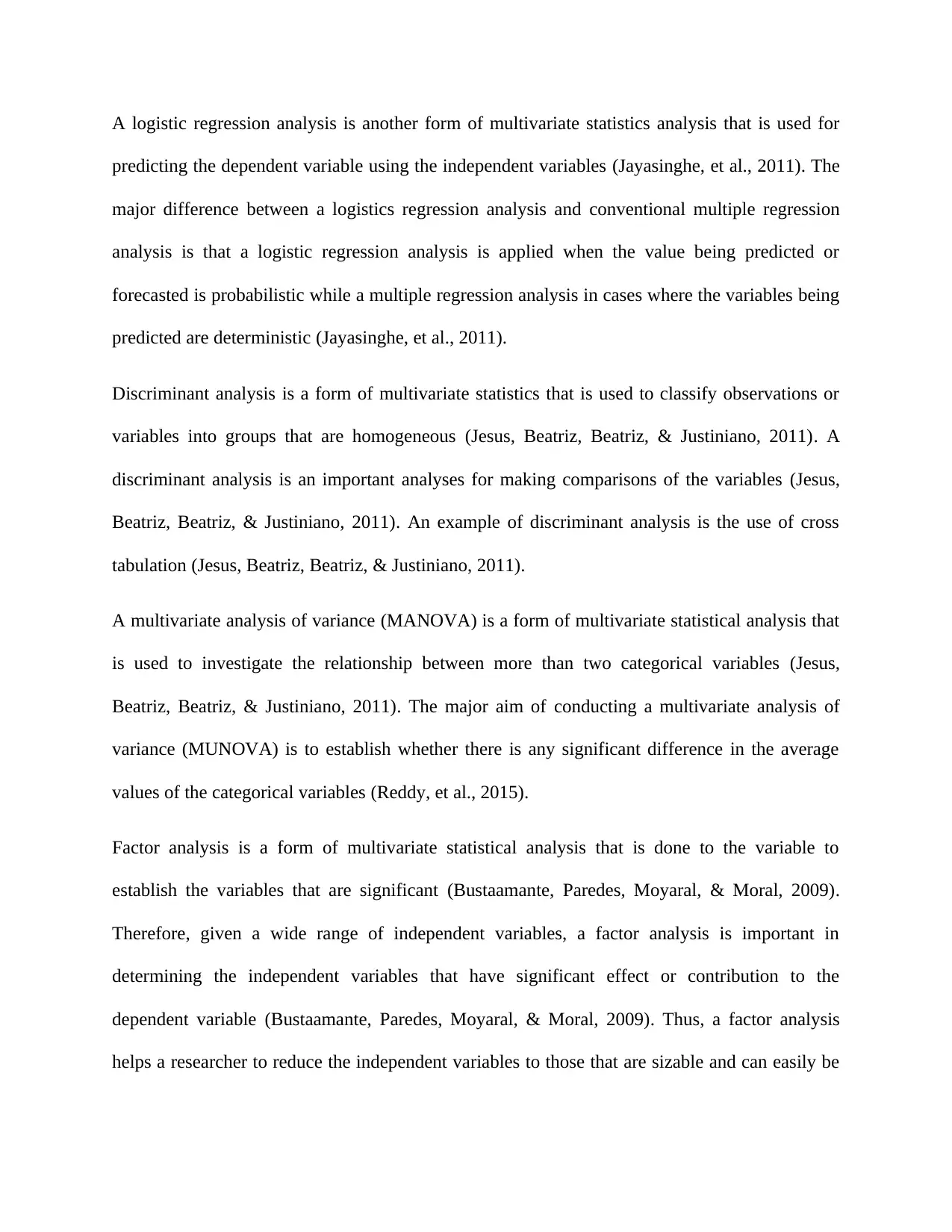
A logistic regression analysis is another form of multivariate statistics analysis that is used for
predicting the dependent variable using the independent variables (Jayasinghe, et al., 2011). The
major difference between a logistics regression analysis and conventional multiple regression
analysis is that a logistic regression analysis is applied when the value being predicted or
forecasted is probabilistic while a multiple regression analysis in cases where the variables being
predicted are deterministic (Jayasinghe, et al., 2011).
Discriminant analysis is a form of multivariate statistics that is used to classify observations or
variables into groups that are homogeneous (Jesus, Beatriz, Beatriz, & Justiniano, 2011). A
discriminant analysis is an important analyses for making comparisons of the variables (Jesus,
Beatriz, Beatriz, & Justiniano, 2011). An example of discriminant analysis is the use of cross
tabulation (Jesus, Beatriz, Beatriz, & Justiniano, 2011).
A multivariate analysis of variance (MANOVA) is a form of multivariate statistical analysis that
is used to investigate the relationship between more than two categorical variables (Jesus,
Beatriz, Beatriz, & Justiniano, 2011). The major aim of conducting a multivariate analysis of
variance (MUNOVA) is to establish whether there is any significant difference in the average
values of the categorical variables (Reddy, et al., 2015).
Factor analysis is a form of multivariate statistical analysis that is done to the variable to
establish the variables that are significant (Bustaamante, Paredes, Moyaral, & Moral, 2009).
Therefore, given a wide range of independent variables, a factor analysis is important in
determining the independent variables that have significant effect or contribution to the
dependent variable (Bustaamante, Paredes, Moyaral, & Moral, 2009). Thus, a factor analysis
helps a researcher to reduce the independent variables to those that are sizable and can easily be
predicting the dependent variable using the independent variables (Jayasinghe, et al., 2011). The
major difference between a logistics regression analysis and conventional multiple regression
analysis is that a logistic regression analysis is applied when the value being predicted or
forecasted is probabilistic while a multiple regression analysis in cases where the variables being
predicted are deterministic (Jayasinghe, et al., 2011).
Discriminant analysis is a form of multivariate statistics that is used to classify observations or
variables into groups that are homogeneous (Jesus, Beatriz, Beatriz, & Justiniano, 2011). A
discriminant analysis is an important analyses for making comparisons of the variables (Jesus,
Beatriz, Beatriz, & Justiniano, 2011). An example of discriminant analysis is the use of cross
tabulation (Jesus, Beatriz, Beatriz, & Justiniano, 2011).
A multivariate analysis of variance (MANOVA) is a form of multivariate statistical analysis that
is used to investigate the relationship between more than two categorical variables (Jesus,
Beatriz, Beatriz, & Justiniano, 2011). The major aim of conducting a multivariate analysis of
variance (MUNOVA) is to establish whether there is any significant difference in the average
values of the categorical variables (Reddy, et al., 2015).
Factor analysis is a form of multivariate statistical analysis that is done to the variable to
establish the variables that are significant (Bustaamante, Paredes, Moyaral, & Moral, 2009).
Therefore, given a wide range of independent variables, a factor analysis is important in
determining the independent variables that have significant effect or contribution to the
dependent variable (Bustaamante, Paredes, Moyaral, & Moral, 2009). Thus, a factor analysis
helps a researcher to reduce the independent variables to those that are sizable and can easily be
Paraphrase This Document
Need a fresh take? Get an instant paraphrase of this document with our AI Paraphraser
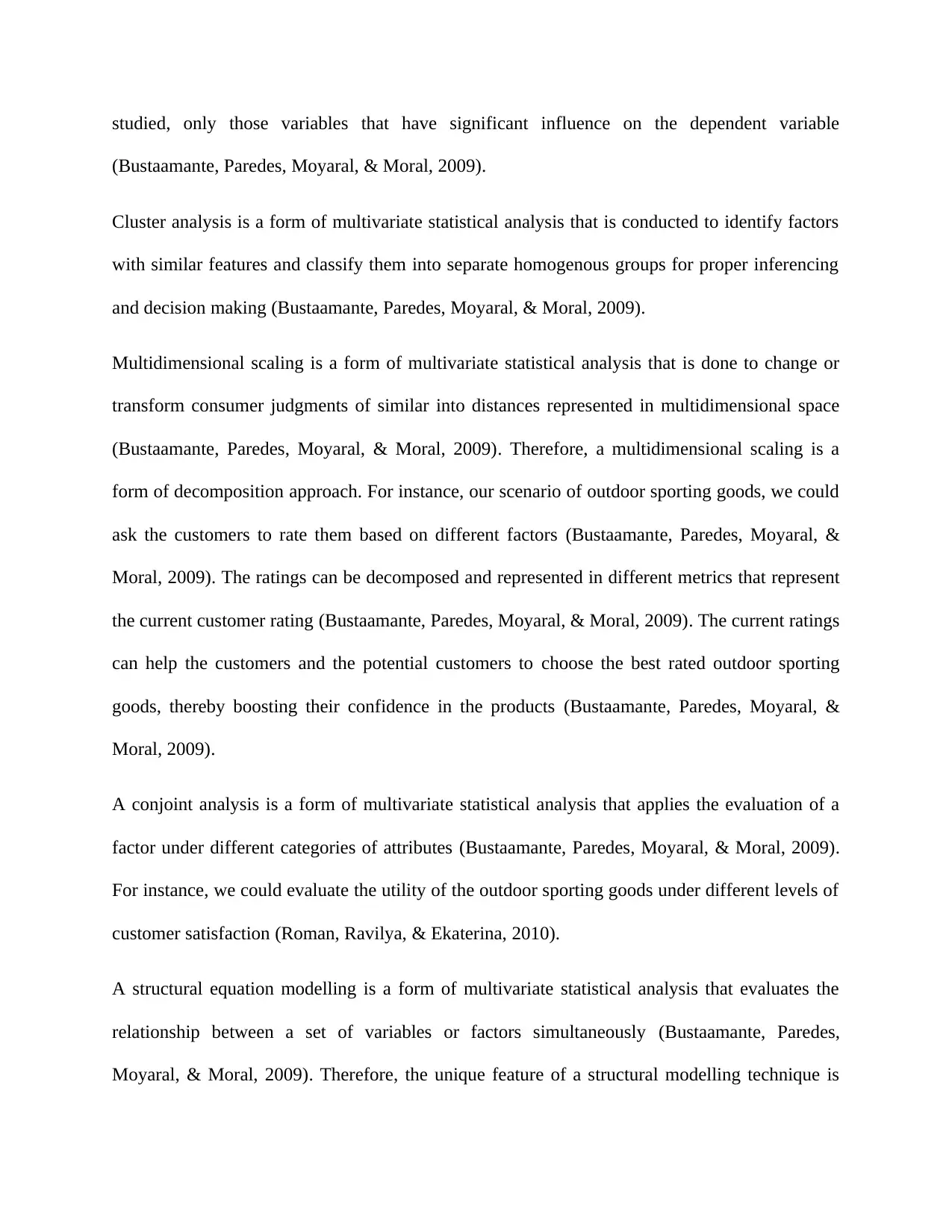
studied, only those variables that have significant influence on the dependent variable
(Bustaamante, Paredes, Moyaral, & Moral, 2009).
Cluster analysis is a form of multivariate statistical analysis that is conducted to identify factors
with similar features and classify them into separate homogenous groups for proper inferencing
and decision making (Bustaamante, Paredes, Moyaral, & Moral, 2009).
Multidimensional scaling is a form of multivariate statistical analysis that is done to change or
transform consumer judgments of similar into distances represented in multidimensional space
(Bustaamante, Paredes, Moyaral, & Moral, 2009). Therefore, a multidimensional scaling is a
form of decomposition approach. For instance, our scenario of outdoor sporting goods, we could
ask the customers to rate them based on different factors (Bustaamante, Paredes, Moyaral, &
Moral, 2009). The ratings can be decomposed and represented in different metrics that represent
the current customer rating (Bustaamante, Paredes, Moyaral, & Moral, 2009). The current ratings
can help the customers and the potential customers to choose the best rated outdoor sporting
goods, thereby boosting their confidence in the products (Bustaamante, Paredes, Moyaral, &
Moral, 2009).
A conjoint analysis is a form of multivariate statistical analysis that applies the evaluation of a
factor under different categories of attributes (Bustaamante, Paredes, Moyaral, & Moral, 2009).
For instance, we could evaluate the utility of the outdoor sporting goods under different levels of
customer satisfaction (Roman, Ravilya, & Ekaterina, 2010).
A structural equation modelling is a form of multivariate statistical analysis that evaluates the
relationship between a set of variables or factors simultaneously (Bustaamante, Paredes,
Moyaral, & Moral, 2009). Therefore, the unique feature of a structural modelling technique is
(Bustaamante, Paredes, Moyaral, & Moral, 2009).
Cluster analysis is a form of multivariate statistical analysis that is conducted to identify factors
with similar features and classify them into separate homogenous groups for proper inferencing
and decision making (Bustaamante, Paredes, Moyaral, & Moral, 2009).
Multidimensional scaling is a form of multivariate statistical analysis that is done to change or
transform consumer judgments of similar into distances represented in multidimensional space
(Bustaamante, Paredes, Moyaral, & Moral, 2009). Therefore, a multidimensional scaling is a
form of decomposition approach. For instance, our scenario of outdoor sporting goods, we could
ask the customers to rate them based on different factors (Bustaamante, Paredes, Moyaral, &
Moral, 2009). The ratings can be decomposed and represented in different metrics that represent
the current customer rating (Bustaamante, Paredes, Moyaral, & Moral, 2009). The current ratings
can help the customers and the potential customers to choose the best rated outdoor sporting
goods, thereby boosting their confidence in the products (Bustaamante, Paredes, Moyaral, &
Moral, 2009).
A conjoint analysis is a form of multivariate statistical analysis that applies the evaluation of a
factor under different categories of attributes (Bustaamante, Paredes, Moyaral, & Moral, 2009).
For instance, we could evaluate the utility of the outdoor sporting goods under different levels of
customer satisfaction (Roman, Ravilya, & Ekaterina, 2010).
A structural equation modelling is a form of multivariate statistical analysis that evaluates the
relationship between a set of variables or factors simultaneously (Bustaamante, Paredes,
Moyaral, & Moral, 2009). Therefore, the unique feature of a structural modelling technique is

that it may contain more than two dependent variables unlike the conventional regression
analysis with only one dependent variable (Beverly, Zapata, & Kreinovich, 2014).
Having discussed the major multivariate statistical analysis methods or techniques, it is
important to point the three most appropriate for D mining (Lapko, 2010). The three most
appropriate multivariate techniques are; the multiple regression analysis, the multivariate
analysis of variance technique and the conjoint analysis technique (Roman, Ravilya, &
Ekaterina, 2010).
A multiple regression is a technique that is used for prediction or forecasting (Li, et al., 2012). A
multiple regression model will be helpful in predicting the volume of sales of the outdoor
sporting goods (Mateu, Lorenzo, & Porcu, 2010). Using the volume of sales as the dependent
variable, there are some other variables that were determined as having effects on the volume of
sales (Reddy, et al., 2015). The multiple regression analysis or modelling will help in coming up
with a model to predict the volume of sales at any time given the factors or determinants (Ritter,
2012).
Multivariate analysis of variance (MANOVA) is useful in analysis the categorical factors or
attributes of the outdoor sporting goods such as the customer rating of the goods, the level of
customer preference for the difference goods and the durability (Roman, Ravilya, & Ekaterina,
2010). A conjoint analysis is useful in grouping the various factors of the outdoor sporting goods
for proper comparison (Roman, Ravilya, & Ekaterina, 2010).
Examples of a real company has used the techniques
The multivariate analysis techniques are used in a wide range of areas and for a wide range of
functions. An example of the use of the multivariate analysis techniques is the ranking of
analysis with only one dependent variable (Beverly, Zapata, & Kreinovich, 2014).
Having discussed the major multivariate statistical analysis methods or techniques, it is
important to point the three most appropriate for D mining (Lapko, 2010). The three most
appropriate multivariate techniques are; the multiple regression analysis, the multivariate
analysis of variance technique and the conjoint analysis technique (Roman, Ravilya, &
Ekaterina, 2010).
A multiple regression is a technique that is used for prediction or forecasting (Li, et al., 2012). A
multiple regression model will be helpful in predicting the volume of sales of the outdoor
sporting goods (Mateu, Lorenzo, & Porcu, 2010). Using the volume of sales as the dependent
variable, there are some other variables that were determined as having effects on the volume of
sales (Reddy, et al., 2015). The multiple regression analysis or modelling will help in coming up
with a model to predict the volume of sales at any time given the factors or determinants (Ritter,
2012).
Multivariate analysis of variance (MANOVA) is useful in analysis the categorical factors or
attributes of the outdoor sporting goods such as the customer rating of the goods, the level of
customer preference for the difference goods and the durability (Roman, Ravilya, & Ekaterina,
2010). A conjoint analysis is useful in grouping the various factors of the outdoor sporting goods
for proper comparison (Roman, Ravilya, & Ekaterina, 2010).
Examples of a real company has used the techniques
The multivariate analysis techniques are used in a wide range of areas and for a wide range of
functions. An example of the use of the multivariate analysis techniques is the ranking of
⊘ This is a preview!⊘
Do you want full access?
Subscribe today to unlock all pages.

Trusted by 1+ million students worldwide
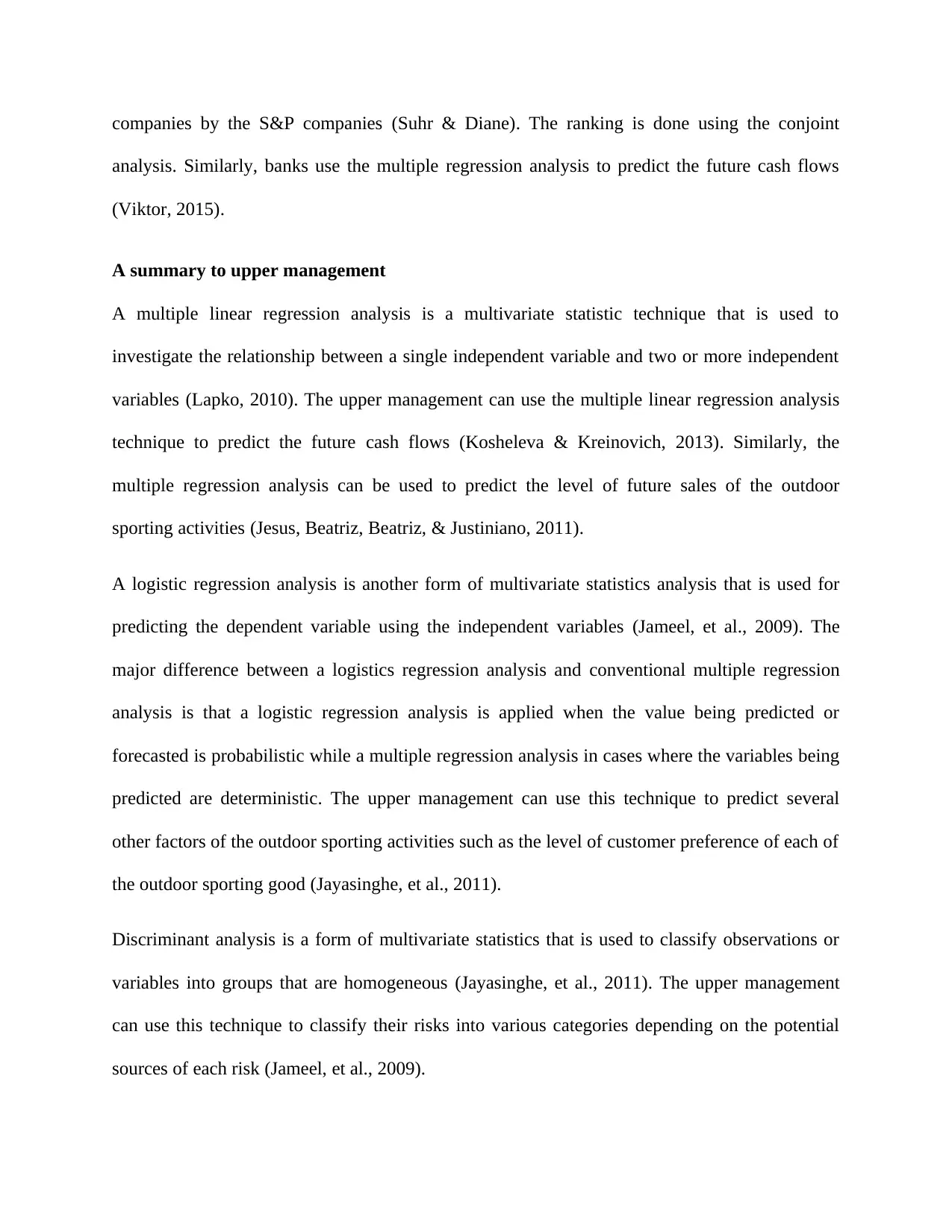
companies by the S&P companies (Suhr & Diane). The ranking is done using the conjoint
analysis. Similarly, banks use the multiple regression analysis to predict the future cash flows
(Viktor, 2015).
A summary to upper management
A multiple linear regression analysis is a multivariate statistic technique that is used to
investigate the relationship between a single independent variable and two or more independent
variables (Lapko, 2010). The upper management can use the multiple linear regression analysis
technique to predict the future cash flows (Kosheleva & Kreinovich, 2013). Similarly, the
multiple regression analysis can be used to predict the level of future sales of the outdoor
sporting activities (Jesus, Beatriz, Beatriz, & Justiniano, 2011).
A logistic regression analysis is another form of multivariate statistics analysis that is used for
predicting the dependent variable using the independent variables (Jameel, et al., 2009). The
major difference between a logistics regression analysis and conventional multiple regression
analysis is that a logistic regression analysis is applied when the value being predicted or
forecasted is probabilistic while a multiple regression analysis in cases where the variables being
predicted are deterministic. The upper management can use this technique to predict several
other factors of the outdoor sporting activities such as the level of customer preference of each of
the outdoor sporting good (Jayasinghe, et al., 2011).
Discriminant analysis is a form of multivariate statistics that is used to classify observations or
variables into groups that are homogeneous (Jayasinghe, et al., 2011). The upper management
can use this technique to classify their risks into various categories depending on the potential
sources of each risk (Jameel, et al., 2009).
analysis. Similarly, banks use the multiple regression analysis to predict the future cash flows
(Viktor, 2015).
A summary to upper management
A multiple linear regression analysis is a multivariate statistic technique that is used to
investigate the relationship between a single independent variable and two or more independent
variables (Lapko, 2010). The upper management can use the multiple linear regression analysis
technique to predict the future cash flows (Kosheleva & Kreinovich, 2013). Similarly, the
multiple regression analysis can be used to predict the level of future sales of the outdoor
sporting activities (Jesus, Beatriz, Beatriz, & Justiniano, 2011).
A logistic regression analysis is another form of multivariate statistics analysis that is used for
predicting the dependent variable using the independent variables (Jameel, et al., 2009). The
major difference between a logistics regression analysis and conventional multiple regression
analysis is that a logistic regression analysis is applied when the value being predicted or
forecasted is probabilistic while a multiple regression analysis in cases where the variables being
predicted are deterministic. The upper management can use this technique to predict several
other factors of the outdoor sporting activities such as the level of customer preference of each of
the outdoor sporting good (Jayasinghe, et al., 2011).
Discriminant analysis is a form of multivariate statistics that is used to classify observations or
variables into groups that are homogeneous (Jayasinghe, et al., 2011). The upper management
can use this technique to classify their risks into various categories depending on the potential
sources of each risk (Jameel, et al., 2009).
Paraphrase This Document
Need a fresh take? Get an instant paraphrase of this document with our AI Paraphraser
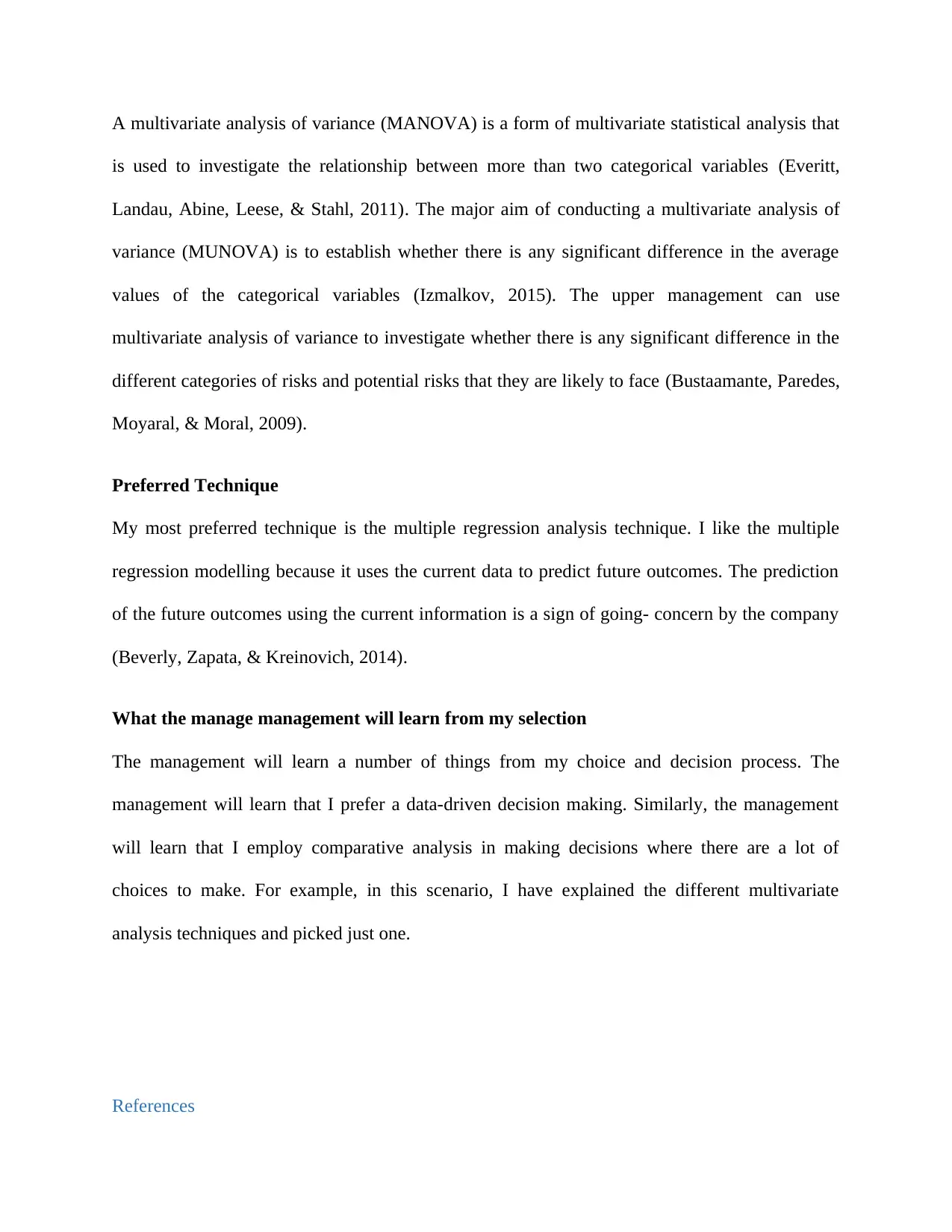
A multivariate analysis of variance (MANOVA) is a form of multivariate statistical analysis that
is used to investigate the relationship between more than two categorical variables (Everitt,
Landau, Abine, Leese, & Stahl, 2011). The major aim of conducting a multivariate analysis of
variance (MUNOVA) is to establish whether there is any significant difference in the average
values of the categorical variables (Izmalkov, 2015). The upper management can use
multivariate analysis of variance to investigate whether there is any significant difference in the
different categories of risks and potential risks that they are likely to face (Bustaamante, Paredes,
Moyaral, & Moral, 2009).
Preferred Technique
My most preferred technique is the multiple regression analysis technique. I like the multiple
regression modelling because it uses the current data to predict future outcomes. The prediction
of the future outcomes using the current information is a sign of going- concern by the company
(Beverly, Zapata, & Kreinovich, 2014).
What the manage management will learn from my selection
The management will learn a number of things from my choice and decision process. The
management will learn that I prefer a data-driven decision making. Similarly, the management
will learn that I employ comparative analysis in making decisions where there are a lot of
choices to make. For example, in this scenario, I have explained the different multivariate
analysis techniques and picked just one.
References
is used to investigate the relationship between more than two categorical variables (Everitt,
Landau, Abine, Leese, & Stahl, 2011). The major aim of conducting a multivariate analysis of
variance (MUNOVA) is to establish whether there is any significant difference in the average
values of the categorical variables (Izmalkov, 2015). The upper management can use
multivariate analysis of variance to investigate whether there is any significant difference in the
different categories of risks and potential risks that they are likely to face (Bustaamante, Paredes,
Moyaral, & Moral, 2009).
Preferred Technique
My most preferred technique is the multiple regression analysis technique. I like the multiple
regression modelling because it uses the current data to predict future outcomes. The prediction
of the future outcomes using the current information is a sign of going- concern by the company
(Beverly, Zapata, & Kreinovich, 2014).
What the manage management will learn from my selection
The management will learn a number of things from my choice and decision process. The
management will learn that I prefer a data-driven decision making. Similarly, the management
will learn that I employ comparative analysis in making decisions where there are a lot of
choices to make. For example, in this scenario, I have explained the different multivariate
analysis techniques and picked just one.
References
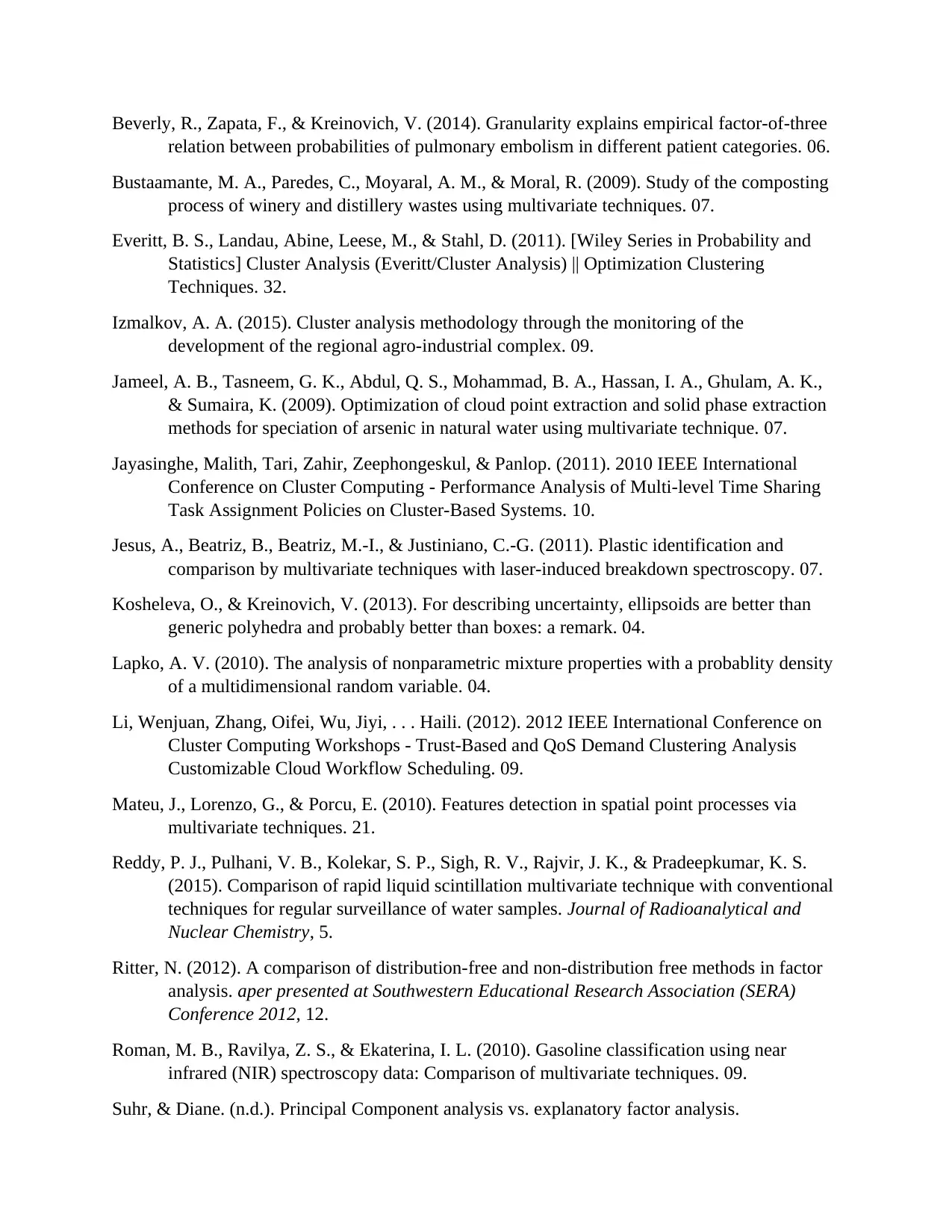
Beverly, R., Zapata, F., & Kreinovich, V. (2014). Granularity explains empirical factor-of-three
relation between probabilities of pulmonary embolism in different patient categories. 06.
Bustaamante, M. A., Paredes, C., Moyaral, A. M., & Moral, R. (2009). Study of the composting
process of winery and distillery wastes using multivariate techniques. 07.
Everitt, B. S., Landau, Abine, Leese, M., & Stahl, D. (2011). [Wiley Series in Probability and
Statistics] Cluster Analysis (Everitt/Cluster Analysis) || Optimization Clustering
Techniques. 32.
Izmalkov, A. A. (2015). Cluster analysis methodology through the monitoring of the
development of the regional agro-industrial complex. 09.
Jameel, A. B., Tasneem, G. K., Abdul, Q. S., Mohammad, B. A., Hassan, I. A., Ghulam, A. K.,
& Sumaira, K. (2009). Optimization of cloud point extraction and solid phase extraction
methods for speciation of arsenic in natural water using multivariate technique. 07.
Jayasinghe, Malith, Tari, Zahir, Zeephongeskul, & Panlop. (2011). 2010 IEEE International
Conference on Cluster Computing - Performance Analysis of Multi-level Time Sharing
Task Assignment Policies on Cluster-Based Systems. 10.
Jesus, A., Beatriz, B., Beatriz, M.-I., & Justiniano, C.-G. (2011). Plastic identification and
comparison by multivariate techniques with laser-induced breakdown spectroscopy. 07.
Kosheleva, O., & Kreinovich, V. (2013). For describing uncertainty, ellipsoids are better than
generic polyhedra and probably better than boxes: a remark. 04.
Lapko, A. V. (2010). The analysis of nonparametric mixture properties with a probablity density
of a multidimensional random variable. 04.
Li, Wenjuan, Zhang, Oifei, Wu, Jiyi, . . . Haili. (2012). 2012 IEEE International Conference on
Cluster Computing Workshops - Trust-Based and QoS Demand Clustering Analysis
Customizable Cloud Workflow Scheduling. 09.
Mateu, J., Lorenzo, G., & Porcu, E. (2010). Features detection in spatial point processes via
multivariate techniques. 21.
Reddy, P. J., Pulhani, V. B., Kolekar, S. P., Sigh, R. V., Rajvir, J. K., & Pradeepkumar, K. S.
(2015). Comparison of rapid liquid scintillation multivariate technique with conventional
techniques for regular surveillance of water samples. Journal of Radioanalytical and
Nuclear Chemistry, 5.
Ritter, N. (2012). A comparison of distribution-free and non-distribution free methods in factor
analysis. aper presented at Southwestern Educational Research Association (SERA)
Conference 2012, 12.
Roman, M. B., Ravilya, Z. S., & Ekaterina, I. L. (2010). Gasoline classification using near
infrared (NIR) spectroscopy data: Comparison of multivariate techniques. 09.
Suhr, & Diane. (n.d.). Principal Component analysis vs. explanatory factor analysis.
relation between probabilities of pulmonary embolism in different patient categories. 06.
Bustaamante, M. A., Paredes, C., Moyaral, A. M., & Moral, R. (2009). Study of the composting
process of winery and distillery wastes using multivariate techniques. 07.
Everitt, B. S., Landau, Abine, Leese, M., & Stahl, D. (2011). [Wiley Series in Probability and
Statistics] Cluster Analysis (Everitt/Cluster Analysis) || Optimization Clustering
Techniques. 32.
Izmalkov, A. A. (2015). Cluster analysis methodology through the monitoring of the
development of the regional agro-industrial complex. 09.
Jameel, A. B., Tasneem, G. K., Abdul, Q. S., Mohammad, B. A., Hassan, I. A., Ghulam, A. K.,
& Sumaira, K. (2009). Optimization of cloud point extraction and solid phase extraction
methods for speciation of arsenic in natural water using multivariate technique. 07.
Jayasinghe, Malith, Tari, Zahir, Zeephongeskul, & Panlop. (2011). 2010 IEEE International
Conference on Cluster Computing - Performance Analysis of Multi-level Time Sharing
Task Assignment Policies on Cluster-Based Systems. 10.
Jesus, A., Beatriz, B., Beatriz, M.-I., & Justiniano, C.-G. (2011). Plastic identification and
comparison by multivariate techniques with laser-induced breakdown spectroscopy. 07.
Kosheleva, O., & Kreinovich, V. (2013). For describing uncertainty, ellipsoids are better than
generic polyhedra and probably better than boxes: a remark. 04.
Lapko, A. V. (2010). The analysis of nonparametric mixture properties with a probablity density
of a multidimensional random variable. 04.
Li, Wenjuan, Zhang, Oifei, Wu, Jiyi, . . . Haili. (2012). 2012 IEEE International Conference on
Cluster Computing Workshops - Trust-Based and QoS Demand Clustering Analysis
Customizable Cloud Workflow Scheduling. 09.
Mateu, J., Lorenzo, G., & Porcu, E. (2010). Features detection in spatial point processes via
multivariate techniques. 21.
Reddy, P. J., Pulhani, V. B., Kolekar, S. P., Sigh, R. V., Rajvir, J. K., & Pradeepkumar, K. S.
(2015). Comparison of rapid liquid scintillation multivariate technique with conventional
techniques for regular surveillance of water samples. Journal of Radioanalytical and
Nuclear Chemistry, 5.
Ritter, N. (2012). A comparison of distribution-free and non-distribution free methods in factor
analysis. aper presented at Southwestern Educational Research Association (SERA)
Conference 2012, 12.
Roman, M. B., Ravilya, Z. S., & Ekaterina, I. L. (2010). Gasoline classification using near
infrared (NIR) spectroscopy data: Comparison of multivariate techniques. 09.
Suhr, & Diane. (n.d.). Principal Component analysis vs. explanatory factor analysis.
⊘ This is a preview!⊘
Do you want full access?
Subscribe today to unlock all pages.

Trusted by 1+ million students worldwide

Viktor, S. (2015). Genetic mutations probability reduction by means of heavy water
consumption. 03.
consumption. 03.
1 out of 10
Related Documents
Your All-in-One AI-Powered Toolkit for Academic Success.
+13062052269
info@desklib.com
Available 24*7 on WhatsApp / Email
![[object Object]](/_next/static/media/star-bottom.7253800d.svg)
Unlock your academic potential
Copyright © 2020–2025 A2Z Services. All Rights Reserved. Developed and managed by ZUCOL.





